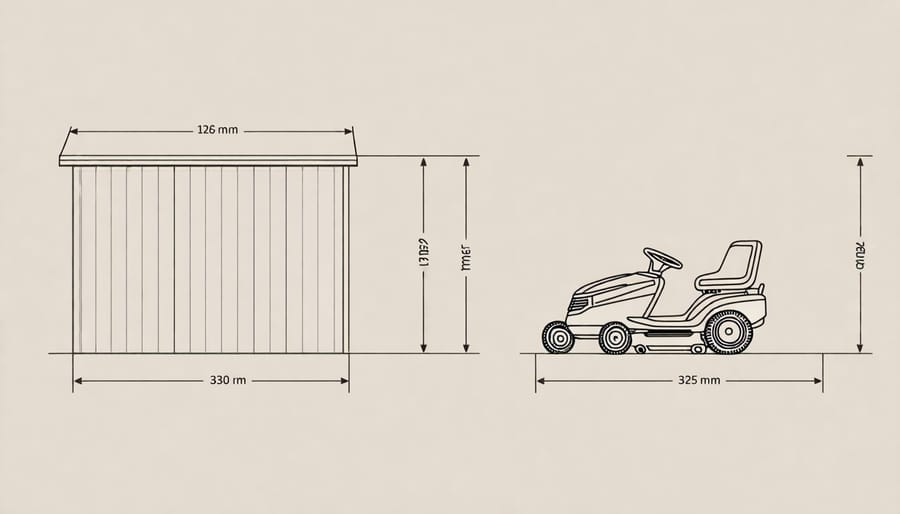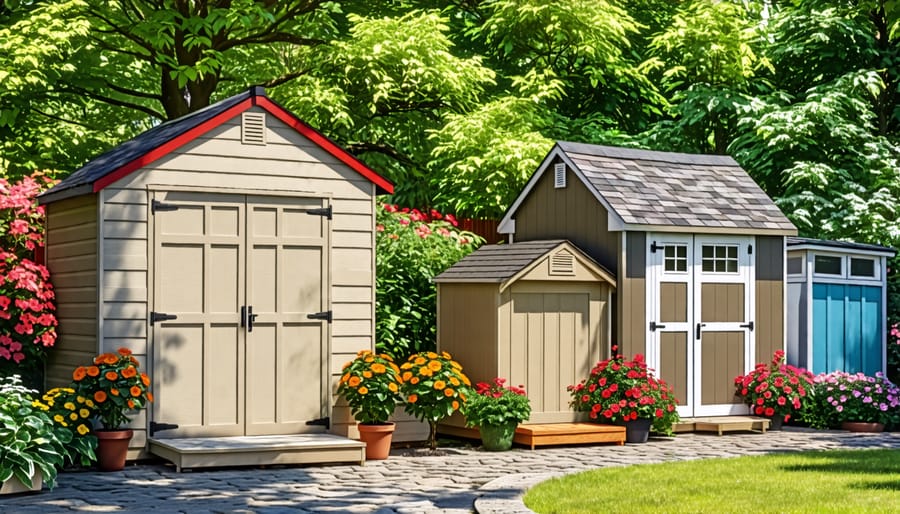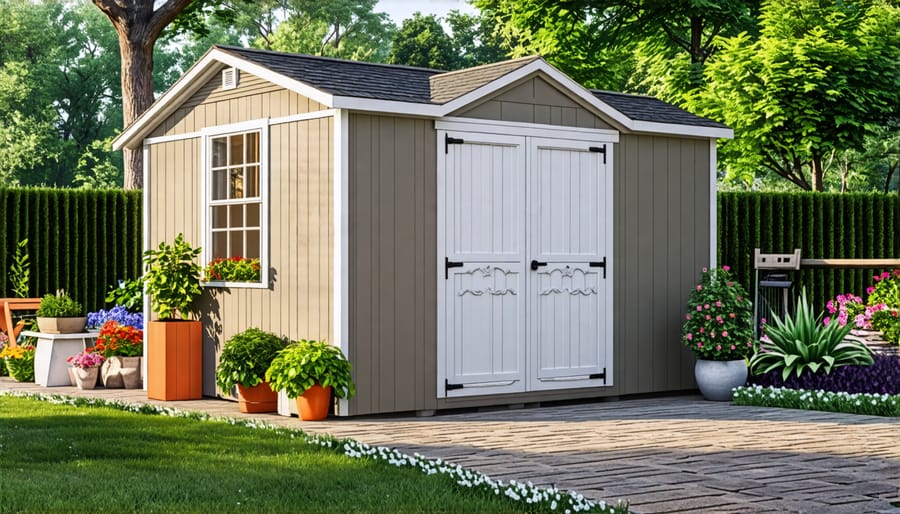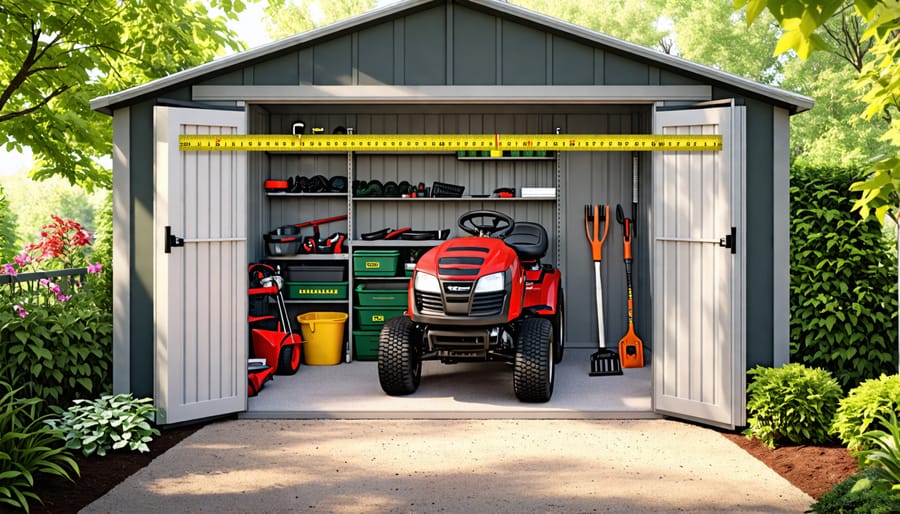Determine the dimensions by measuring your riding lawn mower and accounting for additional storage space. Add a minimum of 12 inches around the mower to ensure comfortable maneuverability. Consider storage needs for tools or other equipment by creating a designated section within the shed. Review local zoning regulations to confirm the maximum allowable shed size for your property.
Understanding Your Shed Needs
Assessing Mower Dimensions
To determine the right shed size for storing your riding lawn mower, start by measuring your mower. An accurate measurement ensures you have enough space for the mower and some extra room for maneuvering and storing additional tools. Begin by measuring the length, width, and height of your mower. If it has an attachment like a bagger or mulching kit, include that in your measurements, as these add extra length.
Once you have your dimensions, consider adding at least an extra foot around your mower for movement and ventilation space. For example, if your mower is 6 feet long, a shed about 8 feet deep would be a feasible choice. This can help prevent the mower from being scratched or damaged and allows you to move around it easily. Additionally, think about any yard equipment or accessories you’d like to store alongside your mower, and factor those into your shed size. By taking these steps, you’ll be better prepared to select a shed that meets your storage needs, keeping your equipment secure and organized.

Additional Storage Requirements
When deciding on the right size shed for your riding lawn mower, it’s essential to consider not just the mower itself but also your additional storage requirements. Many homeowners find that once the mower is tucked away, additional space is needed for tools, spare parts, and other lawn equipment that come in handy for maintaining a beautiful yard. You’ll want to factor in space for essentials like garden tools, fuel cans, and maybe even seasonal items like snow shovels or leaf blowers.
Planning for this extra room is not just about convenience; it’s about creating an organized, fuss-free storage solution that saves you from future headaches. You wouldn’t want to wrestle past a tightly packed shed every time your trimmer needs a tune-up. To effectively organize your shed and make the most out of your space, consider incorporating shelves, hooks, and other space-saving features. This approach ensures that every item has its place, reducing clutter and making it easy to find what you need when you need it.
Real-life testimonials from fellow DIY enthusiasts often highlight the satisfaction that comes from having a shed that caters to all their outdoor storage needs, not just the lawn mower. So as you envision your ideal storage solution, think beyond just today. Plan for growth and new acquisitions, ensuring your shed serves as a versatile hub for all your gardening and maintenance projects over the years.
Standard Shed Sizes and Their Suitability
Small Sheds (Up to 8’x6′)
When contemplating storage solutions for your riding lawn mower, small sheds up to 8’x6′ may initially seem like a tight fit, but they can work under certain conditions. If your riding mower is compact and does not have additional attachments like a bagger or snowplow, this size might just suffice. To ensure a stress-free fit, measure your lawn mower before purchasing a shed—length, width, and height are crucial to making sure it will slide in without a hitch.
For DIY enthusiasts, maximizing space inside the small shed is key. Installing hooks and shelves can provide vertical storage for tools and garden accessories, saving valuable floor space. Keep the shed organized to prevent any obstruction when parking your mower. Also, consider features like double doors or sliding doors for easier access.
Feedback from homeowners reveals that small sheds can be a useful solution when larger storage options are not feasible due to budget or space constraints. However, if you intend to store extra equipment or plan to upgrade to a larger mower in the future, you might want to explore larger or custom-built sheds. Small sheds offer a cozy, functional haven for your lawn care essentials, but ensuring the right fit and setup is essential for a satisfying storage experience.
Medium to Large Sheds (10’x8′ and Larger)
Choosing a medium to large shed, such as a 10’x8′ or larger, can be a game-changer for homeowners looking to safely store their riding lawn mowers and handle various storage needs. These spacious sheds not only accommodate your lawn mower comfortably but also create valuable space for gardening tools, seasonal decorations, or DIY project materials. Imagine having all your outdoor gear neatly organized and easily accessible—a dream for any avid gardener or do-it-yourselfer!
Medium to large sheds offer the flexibility to customize the interior with shelves, hooks, and brackets to maximize storage and functionality. This means no more cramming or struggling to fit tools in tight spaces. You can also consider adding a workbench or potting station for even more efficiency and convenience.
When selecting a shed of this size, think of it as an investment in both functionality and aesthetics. They can enhance your backyard’s appearance, complementing your home’s style while keeping everything tidy and in order. Plus, having ample storage means protecting your expensive mower and tools from harsh weather conditions, ultimately prolonging their lifespan. Speak with neighbors or friends who have made the leap; their experiences often highlight how a well-selected shed can transform not only a backyard but a homeowner’s confidence in their outdoor space.

Personalized Solutions
Custom Sheds for Unique Spaces
When contemplating shed solutions for a riding lawn mower, homeowners might find that custom sheds offer an unmatched level of flexibility and functionality. Custom sheds can be particularly beneficial when dealing with irregularly shaped yards or specific aesthetic desires. For instance, if your backyard has limited space due to landscaping or other structures, a tailor-made shed can maximize every inch, ensuring your riding mower and additional gardening tools are effectively accommodated.
Moreover, if your riding mower comes with attachments or if you plan to store other seasonal equipment like snow blowers, a custom shed can be designed with extra compartments or built-in shelving that meets these unique needs. One homeowner shared how their custom shed not only fit their equipment perfectly but also matched their home’s design, creating a cohesive look that added to their property’s charm.
Lastly, custom designs offer opportunities to incorporate smart access features such as double doors or ramps for easy mower maneuvering, ensuring the shed meets both practical needs and personal tastes.

Real-Life Testimonial
When Megan decided to purchase a riding lawn mower for her sprawling backyard, she quickly realized that her small garden shed wouldn’t suffice. After some research, she settled on a 10×12 shed, which comfortably fits her mower and still offers ample space for other yard tools. “I was surprised by how much more organized my gardening equipment became once everything had a dedicated space,” Megan shares. She also added custom shelving and hooks, making it easy to store smaller tools without compromising floor space. Her advice? “Consider future storage needs and go slightly larger than you think you’ll need.”
Practical Tips for Shed Installation and Maintenance
Foundations and Ground Preparation
Before setting up your shed, it’s crucial to prepare the ground and establish a solid foundation to ensure durability and stability. Start by selecting a level area that allows easy access for your riding lawn mower. Clear the site of any debris, rocks, or vegetation, and use a tamper or roller to compact the soil. Consider laying down a gravel pad or concrete blocks to elevate the shed slightly, promoting good drainage and airflow. This simple step can prevent water damage and extend the life of your structure. A foundation not only supports the weight of your shed but also helps maintain its alignment, preventing doors from sticking. By investing time in proper groundwork, you’re setting the stage for a functional and robust storage solution tailored to your needs.
Regular Maintenance Routines
To keep your shed—and your riding lawn mower—running in top condition, regular maintenance is key. Start by checking the roof and exterior walls for any signs of damage or leaks every few months. Addressing minor wear early, like sealing small cracks or repainting, can prevent larger issues. It’s also important to ensure the doors close securely to protect your mower and other tools from the elements. Inside, keep your shed organized and clutter-free. This ensures you have easy access to your mower and reduces the risk of accidental damage. Consider installing shelves or hooks to store additional equipment neatly. Regularly clean the floor to avoid buildup of grass clippings or dirt, which can attract pests or cause corrosion. These simple steps will help extend the life of your shed and the valuable equipment inside.
Conclusion
Choosing the right shed size depends on a careful assessment of your storage needs and available space. By considering the size of your riding lawn mower and additional equipment, you can select a shed that optimally fits your belongings. Remember to explore various shed designs that balance functionality and style, ensuring both practicality and visual appeal in your yard. Don’t forget that a sturdy base is key; the best foundation for a shed can greatly impact longevity. Also, taking steps to prevent tool rust after installation will protect your investment. Consider your unique requirements, and enjoy the satisfaction of a well-organized and efficient storage solution.





Leave a Reply